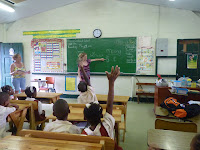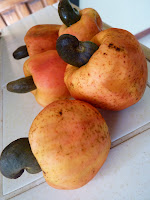
Tracy left the island and it was time to slow down a bit. Janyn and I spent slower days; we had a Banana Daquirie at Sandy Beach and went to the after school program. The last Thursday she was here was Corpus Christi day, a religious holiday.
Elvinette arranged for a large bus to take children to the Mexican Embassy. When she asked if we wanted to attend, we jumped at the idea. The Embassy had an exhibit celebrating it’s 200th anniversary of Independence from Spain.
I’ve become a night person since I retired from the corporate world in 2005. Before coming to Saint Lucia, I taught night classes. Since being here, I start my days after noon. So when Elvinette said we had to be in MoPo to meet the bus at 9:00 in the morning I knew it would be a small challenge.
 The next morning Janyn and I arrived in MoPo just in time for a huge downpour. We took shelter and waited for the bus. As expected, the rain stopped as quickly as it started.
The next morning Janyn and I arrived in MoPo just in time for a huge downpour. We took shelter and waited for the bus. As expected, the rain stopped as quickly as it started. It was a happy bus ride. The children were singing songs and there was excitement in the air. For many children, opportunities to go outside the village are few and so the bus ride was high energy and just plain fun.
It was a happy bus ride. The children were singing songs and there was excitement in the air. For many children, opportunities to go outside the village are few and so the bus ride was high energy and just plain fun. In less than an hour we drove past the sparkling Vigi Beach, past the airport and up a steep hill where the embassy overlooks the Castries Harbor. The Children got out of the bus and waited until everyone was ready to enter.
In less than an hour we drove past the sparkling Vigi Beach, past the airport and up a steep hill where the embassy overlooks the Castries Harbor. The Children got out of the bus and waited until everyone was ready to enter. 
The Mexican Embassy is a tiny room and I wondered how long the exhibit would hold their attention.
 We were in this room for a very long time. To my surprise the children enjoyed every moment.
We were in this room for a very long time. To my surprise the children enjoyed every moment.The Mexican Ambassador was thrilled that we were there.
 He played with the children. They set up tables and played a game of Mexican Bingo and prizes were distributed. He showed them how to play with a top and the interaction was delightful.
He played with the children. They set up tables and played a game of Mexican Bingo and prizes were distributed. He showed them how to play with a top and the interaction was delightful.The children took our camera and captured their moments.






Janyn and I were amazed at how captivated the children were at the Embassy. Confined to a small space for over two hours, they were well behaved and interested.
I thought of my own children and what it might have been like if I had taken them to this exhibit when they were young. Actually, just thinking about it gives me a headache. So lets move on.
We piled back into the bus and moved down the hill until we found a nice shady tree at the beach. We enjoyed a great picnic lunch. Of course, neither Janyn nor I thought far enough ahead to bring food, but we spotted a couple of food stands where we could buy something. Brenda would have none of that. There was plenty of food for us too. The children played American Football on the beach, collected shells and made sandcastles. The ice cream man stopped and scooped cups of cold dessert for us.




And so the day was over and it was time to pile back into the bus for the long ride home.
Janyn and I looked at each other and no words needed to be exchanged. We bid our friends a fond farewell and walked down a two mile stretch on the beach to do - well, what we do best.

































